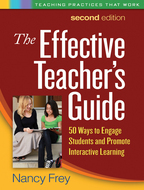The Effective Teacher's Guide
Second Edition
50 Ways to Engage Students and Promote Interactive Learning
Nancy Frey
1. Organize Your Instruction through Gradual Release of Responsibility
2. Active Engagement Is Multileveled: Group–Partner–Individual
3. Instruction Is Interactive: Say–Write–Do
4. Students Help Each Other: Tell–Help–Check
5. Students Learn from Each Other: Think–Pair–Share
II. Engaging Students through Classroom Procedures
6. Creating a Classroom Management Plan
7. Creating and Teaching Classroom Rules
8. Responding to Problem Behaviors
9. Deescalating Problem Behaviors with Voluntary Removal
10. Crumple Doll
11. Responding to Bullying
12. Fostering Problem Solving among Students
13. Room Arrangement
14. Taking Attendance
15. What to Do When a Student Returns from an Absence
III. Engaging Students through Organization
16. Posting a Daily Schedule
17. Signaling the Class
18. Monitoring Noise Level
19. Teaching Students to Manage Their Time
20. Distributing and Collecting Materials
21. Calling on Students
22. Organizing Materials
23. Assignment Headings
24. Teaching Students How to Request Help
25. Managing the Technology in Your Classroom
26. Establishing and Maintaining a Course Website
IV. Engaging Students through Peer Partners
27. Establishing Peer Partners
28. Peer Partners Role 1: Response Partners
29. Peer Partners Role 2: Reading Partners
30. Peer Partners Role 3: On-Task Partners
31. Peer Partners Role 4: Assignment Partners
32. Peer Partners Role 5: Collaborative Partners
33. Grouping Students Efficiently
V. Engaging Students for Learning
34. Interest Surveys
35. Bellwork
36. RAFT (Role–Audience–Format–Topic)
37. Community Surveys
38. Human Graphs
39. Establishing Purpose
40. Vocabulary Routines
41. Whip Around
42. Response Cards
43. Walking Review
44. Jigsaws
45. Self-Corrected Spelling
46. Power Writing to Build Fluency
VI. Engaging Students through Reading
47. Choral Reading
48. Cloze Reading
49. Read-Around
50. Rapid Retrieval of Information



